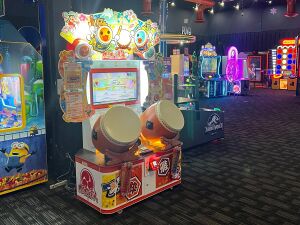Difference between revisions of "Taiko"
(burnt out. probably bachi next but i'm sleepy) |
|||
| Line 1: | Line 1: | ||
[[File:Wild taiko.jpg|thumb|Taiko in their natural habitat.]]'''Taiko''' are [[Japan]]ese drums that come in various sizes. They are the inspiration of the video game series [[Taiko no Tatsujin]]. | [[File:Wild taiko.jpg|thumb|Taiko in their natural habitat.]]'''Taiko''' are [[Japan]]ese drums that come in various sizes. They are the inspiration of the video game series [[Taiko no Tatsujin]]. | ||
| − | In Japanese, the word ''taiko'' (太鼓) refers to any drum, but in other languages more commonly refers to ''wadaiko'' | + | In Japanese, the word ''taiko'' (太鼓) refers to any drum, but in other languages more commonly refers to ''wadaiko'' (Japanese drums), as well as ''kumi-daiko'' ensemble performances. Kumi-daiko is by far the most popularized style of taiko playing, and is generally what taiko is known as internationally. |
== Types of drums == | == Types of drums == | ||
| − | There are several different instruments that are used in | + | There are several different instruments that are used in ''kumi-daiko'', some much rarer than others. |
| − | === | + | ===Nagadō-daiko=== |
| − | [[File:Taiko drum.jpg|thumb|A | + | [[File:Taiko drum.jpg|thumb|A nagadō-daiko set on a ''naname'' (slant) stand.]] |
| − | The most recognizable taiko drum is the '' | + | The most recognizable taiko drum is the ''nagadō-daiko'', a drum shaped like a [[barrel]]. In certain taiko groups, nagadō-daiko were actually constructed ''from'' repurposed barrels. Regardless of the origin of the body, all nagadō-daiko have animal hide stretched over them with high tension to form the drumheads. Once the hide dries, nails are [[Wrench|hammer]]ed around the rim of the head to fasten it into place. |
| − | === | + | ===Shime-daiko=== |
| − | Another common drum seen in | + | Another common drum seen in kumi-daiko is the ''shime-daiko''. This drum is much smaller than nagadō-daiko, having a short height but wide head. The drumskin is stretched over the frame and bound tightly with [[Morshu|rope]] cords to produce a high pitch when played, which contrasts against the deeper bass pitch of the nagadō-daiko. |
| − | Typically, an ensemble performance will consist of multiple | + | Typically, an ensemble performance will consist of multiple nagadō-daiko and at least one shime-daiko. Various other percussive [[instrument]]s may be included, such as the large '' ō-daiko'', a drum which stands vertically, and has a face roughly twice the size of a nagadō-daiko, or ''chappa'', small hand-sized pairs of cymbals that are struck against one another. Additionally, there may be melodic instruments included, such as the ''shinobue'', a transverse flute. |
[[Category:Instruments]] | [[Category:Instruments]] | ||
Revision as of 14:52, 8 October 2023
Taiko are Japanese drums that come in various sizes. They are the inspiration of the video game series Taiko no Tatsujin.
In Japanese, the word taiko (太鼓) refers to any drum, but in other languages more commonly refers to wadaiko (Japanese drums), as well as kumi-daiko ensemble performances. Kumi-daiko is by far the most popularized style of taiko playing, and is generally what taiko is known as internationally.
Types of drums
There are several different instruments that are used in kumi-daiko, some much rarer than others.
Nagadō-daiko
The most recognizable taiko drum is the nagadō-daiko, a drum shaped like a barrel. In certain taiko groups, nagadō-daiko were actually constructed from repurposed barrels. Regardless of the origin of the body, all nagadō-daiko have animal hide stretched over them with high tension to form the drumheads. Once the hide dries, nails are hammered around the rim of the head to fasten it into place.
Shime-daiko
Another common drum seen in kumi-daiko is the shime-daiko. This drum is much smaller than nagadō-daiko, having a short height but wide head. The drumskin is stretched over the frame and bound tightly with rope cords to produce a high pitch when played, which contrasts against the deeper bass pitch of the nagadō-daiko.
Typically, an ensemble performance will consist of multiple nagadō-daiko and at least one shime-daiko. Various other percussive instruments may be included, such as the large ō-daiko, a drum which stands vertically, and has a face roughly twice the size of a nagadō-daiko, or chappa, small hand-sized pairs of cymbals that are struck against one another. Additionally, there may be melodic instruments included, such as the shinobue, a transverse flute.
